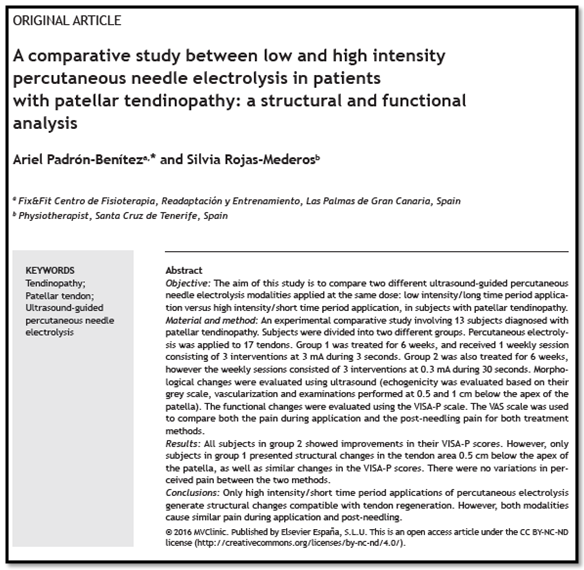Three years ago we were novice in the physiotherapy area and we thank to that, because this has allowed our nouveau development not to be weighed down by previous acquired knowledge. There has been a meticulous design of EPTE® System, based on the current legislation and also in the instructive courses linked to clinical practice.
In spite of that, this Company has suffered different attacks to our way of applicating percutaneous electrolysis through this period of time, by, for instance, publications used in formation courses and scientific meetings that intend to justify the application of some level of electric current, just with comercial incentives. If you desire to know about “Biased results that eventually have a negative impact in the physiotherapy field in general”, please keep reading.
Physiotherapy and biased trials
Over the last year, data obtained in only one study have been used to account for the application of one or other type of current level and maliciously discredit a way of work trying to obtain corporative benefit from a device/s in particular. By using statistics, at least, in a curious manner and extracting a number of conclusions far away from a minimal methodological quality, doubts have been aroused about a clinical practice, with EPTE® Percutaneous Electrolysis Therapy device, in which nowadays more than 3,000 professionals have been instructed.
Thus, we must respond publically, in order to advertise of those inappropriate aspects of a discipline as physiotherapy, healthcare profession, relying on the scientific method, and push electrolysis use aside as a high value tool as part of our treatments.
Comparative study of high and low intensity percutaneous electrolysis in patellar tendinopathy. Functional and structural analysis.
Image 1.Padrón Benítez, Ariel, and Silvia Rojas Mederos. “Comparative study of high and low intensity percutaneous electrolysis in patellar tendinopathy. Functional and structural analysis.” Journal of Invasive Techniques in Physical Therapy 2016;1:10-7.
In relation to this article, an evaluation of different aspects is performed:
• Section 1. Interpretation of results: functional and structural analysis
• Section 2: Methodological validity and statistical management of published data.
At this point, there is need to have a quick glance about STUDY LIMITATIONS, present in the study but it seems no one have read:
“Small size sample, along with lack of randomization and group heterogeneity turn hypothesis test to have a limited reliability”. In relation to subject allocation to groups, this method is the one decided to be used to assure, if feasible, that both groups were comparable in number. Despite from that, the fact that tendinopathy was present bilaterally in some subjects has caused groups not to be exactly equal in number, although groups seemed to be initially comparable. Conversely, data collection was done during a short period of time, so a larger follow-up would be necessary to check that changes are maintained over time or, in contrast, there is a higher number of relapses in group 2 (since there are no morphological changes).
Ultrasound equipment was found to be another limitation, because since the device is medium quality range, maximal resolution is not offered necessary to identify more amount of substantial tissue changes. Reproducing the investigation with higher quality ultrasound devices and even adding sonoelastography study would be appealing, giving more sensitivity to tendinopathy diagnosis. Nevertheless, taking into account that structural changes were found in the closest zone in relation to the treated área, this study justifies the need to perform an ultrasound-guided approach to achieve higher accuracy of the target tissue and optimize efficacy with the highest safety precautions possible.
Thereby, although functional results have been the same after 6 weeks of application, it can be concluded that effects of the implementation of PE at low and high intensity values produce distinct morphological effects. Application mode with higher intensities generate greater changes over the stimulated tendon area, connected to its own regeneration. Nonetheless, both modalities provoke similar pain not only during its working phase, but also in the postpuncture period.”
Taking into account such study limitations, we move forward to evaluate the previously underlined aspects.
Section I. Results interpretation: functional and structural analysis.
In this section, main focus is set on the evaluation of morphological changes and structural analysis performed in the study. Conclusions drawn by Javier Herraiz Garvín, Teaching and Research field Coordinator of Percutaneous Electrolysis EPTE®, can be checked out on thislink.
Section 2. Methodological validity and statistical management of published data.
In this section, main focus stays on the evaluation of methodological validity and statistical management of published data.
Such analysis has been carried out by two cooperation partners, from Spain and Holland, Irene de la Rosa, PT, PhD. Grupo de Investigación FPSM, Universidad de Alcalá , and Floris Goes, PhD Candidate Sport Sciences and Physiotherapist, respectively, markets in which percutaneous electrolysis has been accepted as an invasive technique to be considered within the therapeutic arsenal available for the treatment of tendinous pathological entities.
Evaluation and conclusions from both partners can be reviewed on the next links.
From the previous considerations, bias in data management can be concluded and no validity is found from the obtained data of this examined clinical trial.
Therefore, a commercial strategy has been created based on erroneous and biased data in terms of methodological issues, and this type of actions are not beneficial for the physiotherapy field and its working professionals, calling into question our strictness and criteria.
This article, being also the fundamental base of the last Invasive Physiotherapy Congress (II International Congress of Invasive Physiotherapy 2016), cannot be supported in any of its statements. For those that, as well as happens to us that we rather read and extract our own interpretations or to listen to others, a link of the journal is available to be downloaded and reviewed.
EPTE® is committed with research and development of this field, reason why there are different randomized clinical trials registered in Clinical Trials. We are opposed to the biased and arbitrary use of information.

.

